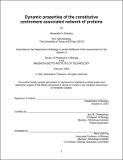Dynamic properties of the constitutive centromere associated network of proteins
Author(s)
Navarro, Alexandra P.
DownloadThesis PDF (11.39Mb)
Advisor
Cheeseman, Iain M.
Terms of use
Metadata
Show full item recordAbstract
Ensuring the proper transmission of genetic material across generations is fundamental to the propagation of cellular life. In each mitotic cell division, a series of highly regulated processes ensure that the genetic material of a dividing cell is properly duplicated and segregated to produce two genetically identical daughter cells. The distribution of genetic material requires the attachment of spindle microtubules to a specified region of the genome called the centromere. This attachment is mediated by the proteinaceous structure called the kinetochore. To enact its function the kinetochore must ensure the proper assembly of its two functional domains: the inner kinetochore referred to as the constitutive centromere associated network (CCAN), which is assembled specifically at the centromere; and the outer kinetochore, which directly interacts with spindle microtubules and is assembled strictly in mitosis. The proteins of the CCAN are characterized by their constitutive localization to the centromere throughout the cell cycle. However, the different processes the occur at each stage of the cell cycle enact distinct changes to the centromere that would require the CCAN to adapt to these changes. However, the molecular mechanisms that contribute to reorganization have not been fully elucidated.
In this thesis work, I demonstrate that a component of the CCAN called the CENP-LN complex displays cell cycle dependent kinetochore localization behaviors. Although the CENP-LN complex is always present at the kinetochore, it is distinctly enriched in S-phase. Utilizing genetic manipulation and cell biological analyses in mammalian cells, I demonstrate that the cell cycle dependent phosphorylation of either CENP-L or CENP-N regulates the localization of this complex. In this process, phosphorylation negatively affects the interaction between these two proteins and therefore prevents their localization to the kinetochore in mitosis. Alternatively, precluding phosphorylation does not affect their interaction but prevents their localization to the kinetochore during interphase. Additionally, in my studies of the function and behavior of the CCAN, we serendipitously identified a small 37 amino acid peptide that is encoded by an alternative open reading frame within the mRNA of the CENP-R gene. This small peptide uniquely localizes to the Golgi. In my work, I utilize this short peptide sequence to identify a minimal 10 amino acid signal sequence that is sufficient for Golgi targeting and localization.
Date issued
2022-02Department
Massachusetts Institute of Technology. Department of BiologyPublisher
Massachusetts Institute of Technology